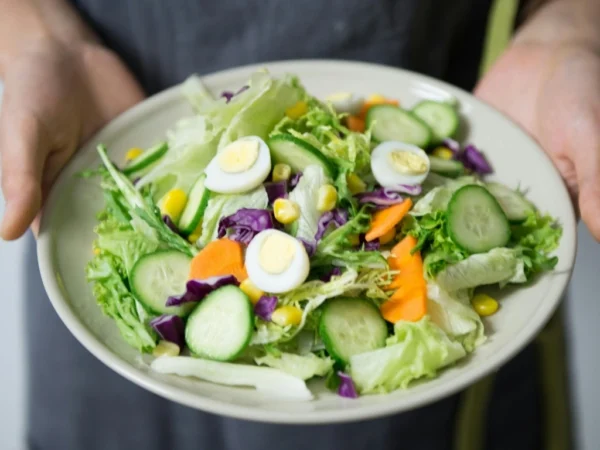Olives are an incredibly popular food item present in a number of dishes, from charcuterie boards to pizza and even beverages. It has led many individuals following a low FODMAP diet to wonder, “Are Kalamata olives low FODMAP?”
Kalamata olives have not been formally tested by Monash University to determine the FODMAP content present in a serving. However, it is presumed that this particular olive would be low in FODMAPs, given that pitted black and green olives are low FODMAP choices. In this article, we will explore the commonly asked questions regarding olives and ways to implement a variety of olives while following a low FODMAP diet.

Calories in a Serving of Kalamata Olives
A serving of pitted Greek Kalamata Olives from the Mezzetta brand provides:
- Serving Size: 4 Olives (15g)
- Calories: 35 kcals
- Total Fat: 3g
- Sodium: 240 mg
- Total Carbohydrates: 3g
- Fiber: 2g
- Protein: 0g
Kalamata Olives are low in calories and carbohydrates and provide a beneficial serving of healthy fats and fiber.
Kalamata Olives Low FODMAP Content
Kalamata olives do not have an official entry in the Monash University Low FODMAP diet planning app. However, based on available data from Monash University, both pitted green and black olives are low in identified FODMAPs.
A low FODMAP serving of either black or green pitted olives is 15 small or ½ cup per meal time. Olive oil is another low FODMAP choice, and Monash has identified a low FODMAP serving to be 1 tablespoon per meal.
Even though Kalamata olives do not have an official entry in the Monash App, it can be beneficial to test your individual tolerance to this particular food item. An example would be to start with the suggested serving size on the package and keep a food symptom journal for noting if any reaction was present after consuming the food item.
Benefits of Including Olives in Your Diet
Olives are a nutrient-dense food item that can be included in a number of dishes. Olives provide a source of healthy fats, and increasing the intake of healthy fats in meal and snack choices can increase meal satisfaction.
Olives also provide a beneficial source of dietary fiber that can assist in blood sugar management and are a low glycemic index choice. According to Harvard Health, increased amounts of dietary fiber have been linked to lower blood pressure and lower cholesterol levels. The American Heart Association also supports an increase in dietary fiber for heart health, as well as weight management, as fiber helps you to stay fuller for longer.
Lastly, olives contain Vitamin E, which is a fat-soluble vitamin that acts as an antioxidant in the body, working to reduce oxidative stress, lower inflammation, and prevent damage in the body caused by inflammation.
Kalamata Olives Low FODMAP Considerations
There are a few considerations when including Kalamata olives in your diet while following a low FODMAP diet. These considerations include the following questions:
- Are the olives produced in a brine that also contains garlic and onions? Reminder – garlic and onions are not FODMAP-friendly.
- Are the olives stuffed with a cheese or other food that is not FODMAP-friendly?
- Does excess salt or sodium in a meal or snack choice contribute to GI symptoms such as bloating? This is important as olives contain higher amounts of sodium.
Kalamata Olives Low FODMAP Recipe
Please see a recipe from the low FODMAP brand, Fody Foods, for a Marinated Low FODMAP Mozzarella and Olives recipe.

Cook Time: 5 Minutes
Servings: 12
Ingredients:
- 8 oz bite-sized mozzarella balls
- 2 ounces pitted black olives or Kalamata olives
- 2 ounces pitted green olives
- ¾ cup Fody Low FODMAP Garlic Infused Olive Oil
- ¾ cup Fody Low FODMAP Shallot-Infused Olive Oil
- 2 teaspoons red pepper flakes (to taste)
- 1 teaspoon Fody Low FODMAP Lemon and Herb Seasoning
Directions:
- Combine all ingredients into a container and refrigerate for several hours or overnight. Serve at room temperature and enjoy!
- Pair with your favorite gluten-free crackers or seed crackers, as well as ½ cup diced cucumber and carrots for your own nutrient-dense charcuterie board.

Conclusions
Kalamata olives have not been officially tested for their FODMAP content; however, that does not mean you should avoid this food, as olives in general can be consumed on a low FODMAP diet and provide several important nutrients, including healthy fats, Vitamin E, and dietary fiber. If you are looking for further foods to add to your meal or snack routine that are low in FODMAP and nutrient-dense dense then please consider setting an evaluation with a Registered Dietitian from Health Loft Nutrition to discuss additional meal planning strategies.













